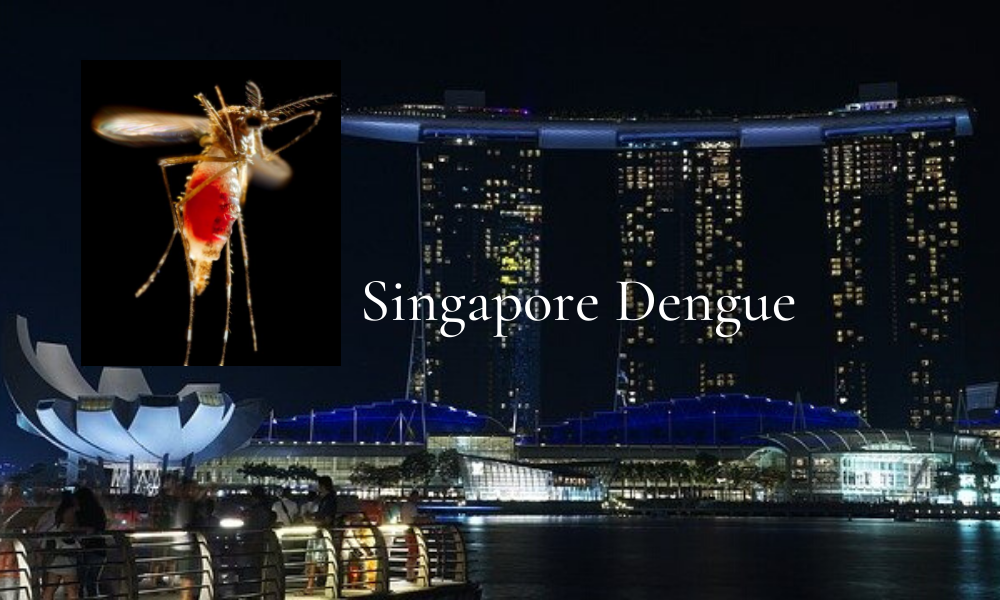NewsDesk @bactiman63
In a follow-up on the dengue fever outbreak in Singapore, the National Environment Agency (NEA) has reported 15,618 cases this year through Friday.

In a speech last Wednesday by Ms Grace Fu, Minister for Sustainability and the Environment, at 5th Asia Dengue Summit discussing the Singapore situation:
Against this backdrop of low population immunity, with favourable climatic conditions for mosquito breeding, and the continued presence of dengue mosquitoes and viruses, Singapore continues to experience regular dengue outbreaks. 2020 saw our largest outbreak to date, with more than 35,000 cases and 32 deaths. In 2022, we are once again in the midst of an outbreak: more than 14,000 cases have been reported to date, with an earlier-than-usual surge in dengue cases that began in March. Weekly cases could very well surpass the record of 1,800 seen in 2020 and may even exceed 2,000 soon, and we are just at the beginning of the traditional peak dengue season from June to October. As the dominant strain this year is the dengue virus serotype 3 (DENV-3), which has been rarely seen in Singapore, this means that population immunity among Singapore residents is low. This urgent situation calls for everyone, including individuals and premises owners to do their part to break disease transmission, by being vigilant against stagnant water and potential mosquito breeding habitats in our homes and premises.
While source eradication remains our main strategy for dengue control, “business as usual” is not an option given the escalating threat of vector-borne diseases. Since 2016, we have thus invested significantly in research into innovations that could complement and enhance conventional control measures or at least mitigate the impact of outbreaks.
Our flagship programme, Project Wolbachia, involves releases of male Wolbachia-carrying Aedes aegypti mosquitoes to suppress the urban Aedes aegypti mosquito population in the community. Being the first to trial and implement this technology in a high-rise, high-density urban tropical environment, we rolled out releases using a phased approach to evaluate impact systematically and rigorously. Field releases began in 2016 on a small scale, covering 39 public housing apartment blocks, also known as HDB blocks. We have now expanded coverage to over 1,800 HDB blocks in towns which experienced dengue outbreaks and high Aedes aegypti populations. These include full coverage of Yishun and Tampines towns, as well as targeted releases in Choa Chu Kang and Bukit Batok towns. Releases in the Marine Parade landed residential estate have also begun.
The results so far have been promising. In areas of Tampines and Yishun where releases have been ongoing for more than a year, we have seen up to 98 per cent suppression of the urban Aedes aegypti mosquito population, and up to 88 percent reduction in dengue cases. In the current outbreak, these two towns have 70 per cent fewer dengue cases compared to similar areas without Wolbachia. Over in Choa Chu Kang and Bukit Batok, areas with at least a year of releases show dengue case reductions of up to 53 per cent.
Subscribe to Outbreak News TV on YouTube
Today, I am pleased to announce that NEA will expand Project Wolbachia to an additional 1,400 blocks in eight areas from July this year. Besides reducing the population of Aedes aegypti mosquitoes in these areas, the expansion will allow us to understand the impact of a large-scale multi-site deployment of Wolbachia technology on dengue cases. The study has been scientifically designed, and sites were determined based on a set of criteria, including historical dengue risk level, Aedes aegypti population, size and landscape of the area, and distance between release sites. With this expansion, Project Wolbachia will cover an estimated 300,000 homes, an increase from the current 160,000. This will cover 31 per cent of all HDB blocks in Singapore, up from the current 19 per cent. Releases will also take place at selected construction sites and non-HDB residential sites in dengue high-risk areas.
To support the expansion, NEA will increase the production of male Wolbachia-Aedes mosquitoes from 2 million per week to 5 million per week. This is made possible by our collaboration with local company Orinno Technology, with the support of the National Robotics Programme. NEA and Orinno have co-developed engineering solutions to automate the mass production and release of male Wolbachia-Aedes mosquitoes, improving the efficiency of mosquito production by up to 40 times as compared to conventional manual methods. To complement NEA’s mosquito production and release efforts, we have also partnered with Verily Life Sciences, which has contributed to gender-sorting and release of male Wolbachia-Aedes mosquitoes at the Tampines and Marine Parade study sites. NEA will continue to build in-house capability and work with our collaborators to further scale up our capacity so as to expand the project to more areas progressively.
- Australia: Measles case identified in a Melbourne resident
- Maryland reports 1st presumed human monkeypox case
- DRC typhoid tally for 2022 is 755,014 cases year to date
- Ghana reports monkeypox outbreak, 5 confirmed cases
- Measles reported in Ohio for first time since 2019
- Nevada officials report first probable monkeypox case in Clark County, US cases reach 100
- Polio in Pakistan: Two additional cases reported in North Waziristan, One fatal
- San Diego reports two probable monkeypox cases
- Afghanistan: 50,000 measles cases in five months
- North Korea: New ‘outbreak’ in Haeju, COVID-19 update


2 thoughts on “Singapore dengue outbreak: ‘Business as usual’ is not an option given the escalating threat of vector-borne diseases”